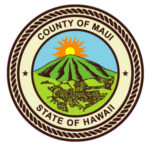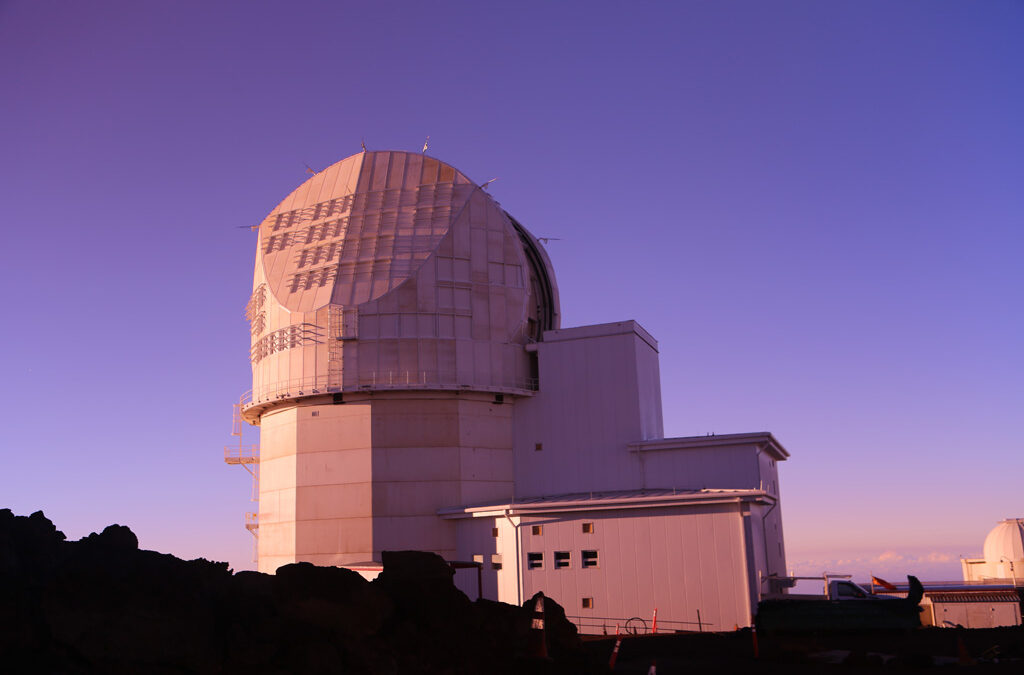
Nov 9, 2016 | Environment, Innovation

The Daniel K. Inouye Solar Telescope (DKIST) is on schedule for full operations in June 2020. Situated at 10,000 feet of elevation atop Haleakala, the DKIST will be the most advanced ground-based solar observatory in the world. With more than 20 institutions collaborating internationally, it is about to revolutionize the world of solar astronomy. “We are pointing a four-meter (13 foot) telescope at the Sun for the very first time, which will challenge the science community to take their understanding to a whole new level,” said Dr. Thomas Rimmele, DKIST Project Director, National Solar Observatory (NSO). “When combined with a special adaptive optics system, the DKIST’s primary mirror will produce high-speed measurements to examine the Sun’s surface in stunning detail!”
The site on Haleakala was selected, out of a global search, for its clear daytime atmospheric seeing conditions. Once operational, the DKIST will allow astronomers to measure the magnetic fields that drive space weather events such as solar flares and coronal mass ejections. “Understanding the behavior of the Sun’s magnetic fields is vital,” Rimmele explained. “Monitoring space weather is essential as our society increasingly relies on electronics technology that is susceptible to damage from these large space events. DKIST will help us better deal with threats of outages.”
DKIST Project Manager Dr. Joseph McMullin of NSO provided the latest updates. “The external building has been completed, with the integration of major telescope systems underway. This includes the telescope mount assembly and the rotating instrument laboratory,” McMullin noted. “The optical systems, and the primary mirror, the most critical element of the telescope, have met their challenging, state-of-the-art specifications and are undergoing testing.”
DKIST’s open data policy will provide the general public access to unique data resources compiled by the best engineers and scientists in the world. “In fact, the DKIST will bring more jobs and educational outreach opportunities to Maui,” Rimmele added. “The scientific impact from the DKIST, for all of humanity, is immense. The entire global community will be looking to Maui for this extraordinary science!”
Permitting us to measure the magnetic fields in the solar atmosphere for the very first time, the DKIST will fill in many gaps of our knowledge of the Sun and its magnetic activities.
Dr. Thomas Rimmele, DKIST Project Director, National Solar Observatory
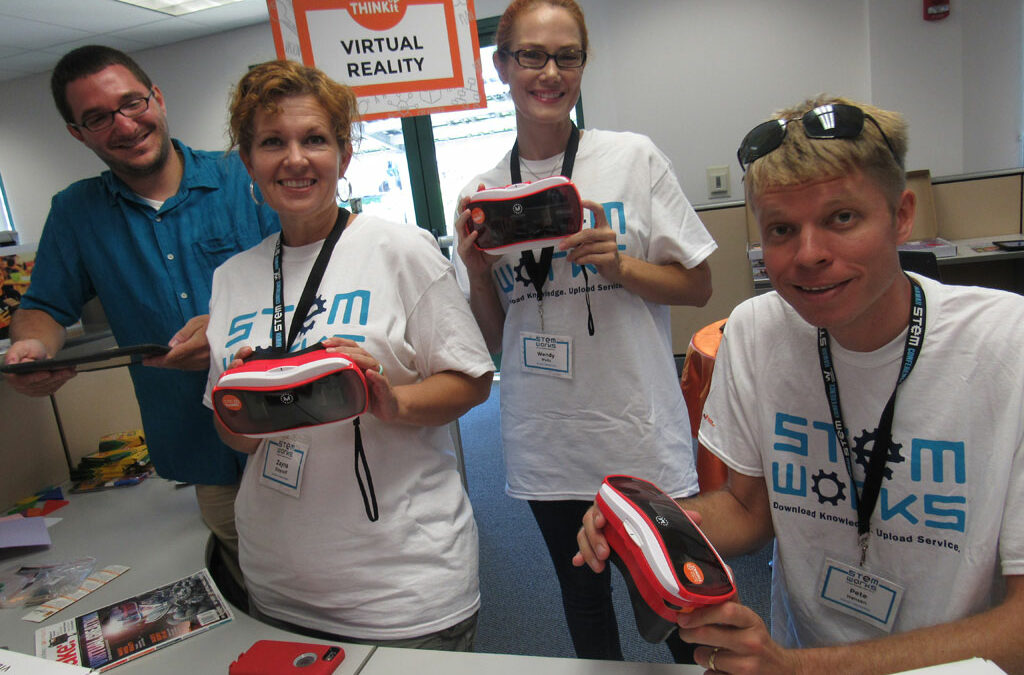
Oct 19, 2016 | Education, Innovation

Maui Economic Development Board’s (MEDB) Women in Technology (WIT) Project presented a two-day STEMworks™ Professional Development (PD) Workshop. STEMworks™ is a multi-faceted, hands-on STEM (science, technology, engineering, and mathematics) program. In this approach to learning, students get to use the most current, high-end technologies in actual community-service learning projects. Facilitators in the STEMworks™ Afterschool program attended the workshop from across the state, representing 27 elementary, middle and high schools.
“We revealed our new THINKit Kits that each STEMworks™ lab will have,” said Melinda White, MEDB WIT Project Manager. “The THINKit kits are designed to nurture creativity and build excitement and competency in the classroom. The contents will help students access STEMworks™ tools such as CAD software, Adobe products, coding languages and more.”
“With new technologies, ingenuity and higher expectations, we are living today in the most dynamic era in learning and education,” White said. “We hope that THINKit will create opportunities to unlock passions, talents, and strengths for students, now and in the future.”
“The STEMworks™ Teacher PD workshop gave me a new perspective on teaching,” said Peter Hansen, computer resource teacher for grades K-5 at Kamali’i Elementary School. “WIT and MEDB have always been so generous in securing the resources that I need as a teacher to implement new lessons. It is fantastic that they have assembled a set of items into a THINKit kit that will be given to each STEMworks™ school. I can only imagine the possibilities now that my students will have access to drones, robots, virtual reality viewers and much more.”
WIT brought trainers and speakers, including a special virtual visit from Pixar chief scientist Tony DeRose, to help the educators work with the tools in their THINKit kits. “Events like this are so valuable for teachers and by extension their students,” Hansen added. “It was great to talk with one another and to brainstorm how we intend to use the STEMworks™ curriculum and resources in our schools to help shape new inventive and entrepreneurial thinking.”
THINKit provides educators with a continuum of tools that advance critical thinking and skill from kindergarten to college to career!
Melinda White, MEDB WIT Project Manager

Sep 21, 2016 | Innovation
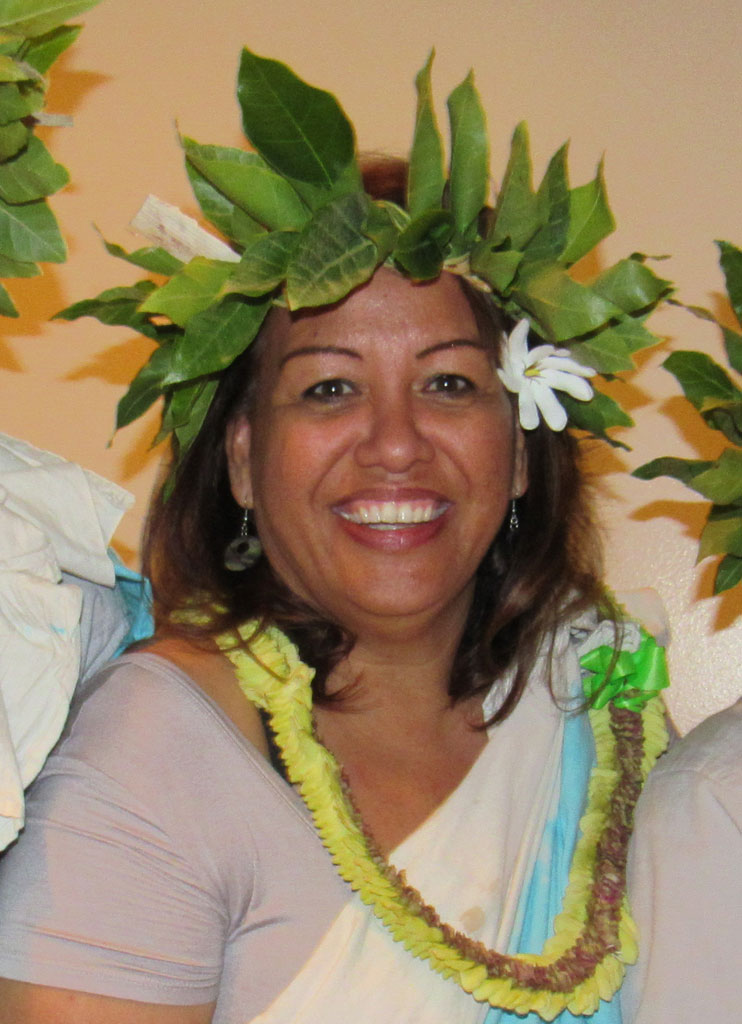 Sponsored by Maui Economic Development Board (MEDB), ‘Iolani Ku’oha, a Hawaiian Language Immersion Program (HLIP) teacher for ‘O Hina I ka Malama at Molokai Middle School, recently attended GenCyber Summer Camp on Kauai. The camp, which is funded jointly by the National Science Foundation and the National Security Agency, provides educators and students with the tools they need to be safe and responsible online. “Using current technologies through hands-on-activities, cyber security experts introduced the camp participants to the concept of digital citizenship and online safety information,” said Ku’oha. “With this new experience, I can help my students learn the basics of coding, another language form, and also reinforce their interest in STEM (science, technology, engineering and mathematics) careers.”
Sponsored by Maui Economic Development Board (MEDB), ‘Iolani Ku’oha, a Hawaiian Language Immersion Program (HLIP) teacher for ‘O Hina I ka Malama at Molokai Middle School, recently attended GenCyber Summer Camp on Kauai. The camp, which is funded jointly by the National Science Foundation and the National Security Agency, provides educators and students with the tools they need to be safe and responsible online. “Using current technologies through hands-on-activities, cyber security experts introduced the camp participants to the concept of digital citizenship and online safety information,” said Ku’oha. “With this new experience, I can help my students learn the basics of coding, another language form, and also reinforce their interest in STEM (science, technology, engineering and mathematics) careers.”
Through attending the Kauai GenCyber Camp, Ku’oha was invited to attend the Colorado GenCyber Camp held at the Denver Language School, a dual immersion language school teaching in Spanish and Cantonese. “This was a great opportunity for me to collaborate with other Immersion teachers and develop tutorial strategies in our specific language,” Ku’oha said. “I came away with a comprehensive set of lesson plans mapped to appropriate standards, which I will be using with my students; a starter kit in robotics, which I’ve already implemented in my classroom; and a network of like-minded Immersion teachers to share future ideas with.”
“I discovered Ozobots at camp,” Ku’oha explained. “This tiny toy robot blends the physical and digital worlds; and teaches programming. Ozobots can identify lines, colors, and codes on both digital surfaces, such as an iPad, and physical surfaces, such as paper. The tiny robots offer fun teaching methods for delivering cybersecurity content in K-12 computer science curriculum.”
Because of her summer experience in both camps, Ku’oha was chosen from among a few teachers in Hawaii and Colorado to attend an upcoming GenCyber program in Alaska. “I wouldn’t have these opportunities without the support of MEDB and Women in Technology,” she added. “I’m so grateful to them!”
The GenCyber program ensures that students understand correct and safe online behavior; especially as society becomes more reliant on cyber-based technology in every aspect of daily life.
‘Iolani Ku’oha, Molokai Middle School, HILP Teacher
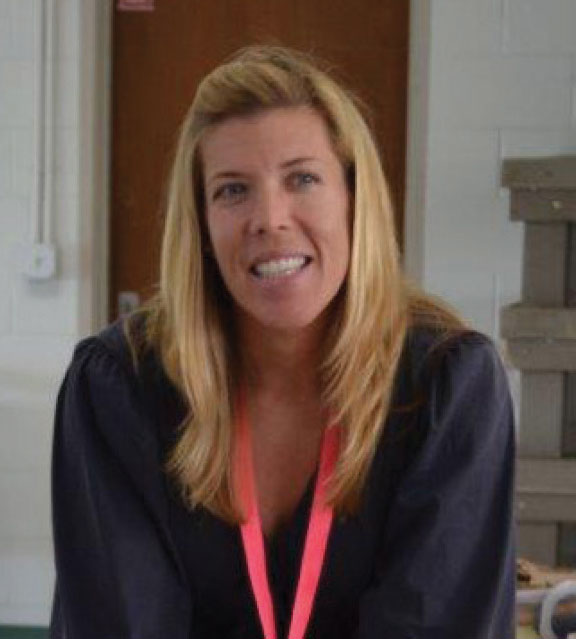
Mar 3, 2016 | Education, Innovation
Maui girls in grades 7-8, accompanied by teachers, discovered the exciting and lucrative field of engineering during Introduce a Girl to Engineering Day (IGED) on Thursday, February 25th, at Maui Research and Technology Park. In observance of National Engineers Week, Maui Economic Development Board’s Women in Technology (WIT) program hosts the popular event to expose girls to the male-dominated field of engineering and encourage them to become engineers themselves. For the past 16 years, WIT has teamed up with the County of Maui, Maui Electric and local industrial firms to provide a day of hands-on activities and worksite visits. Along with raising awareness of the contribution engineers make to the community, IGED also introduces students to science, technology, engineering and mathematics (STEM).
According to WIT Project Manager Mapu Quitazol, women still represent less than 5% of engineers in Hawaii and studies predict there will be a further shortage of engineers in the next two decades. “Together, we can challenge those daunting statistics,” Quitazol said. “The sooner we get girls engaged in the field, the faster they can begin learning the skills to compete for these high-paying, in-demand jobs. In fact, Quitazol noted, “engineering is the number one job that parents should be encouraging their girls to pursue.”
 Senior Project Engineer Fiona van Ammers from SSFM International, Inc., a Hawaii-based professional engineering business, advocates for participation in the WIT Program. “It is important to develop future leaders through community-based programs designed to address planning for Maui’s future,” she said. “IGED engages young women in meaningful events that add to their skill set and inspire them to choose a STEM career.” Fiona explains to students that civil engineering is about creating designs that improve and protect the environment and human lives. This is demonstrated by explanation of what work was required to complete the Maui Memorial Medical Center Helipad, for which Fiona was the civil engineer and project manager. For the past decade, WIT has been at the forefront of providing cutting-edge STEM programs across the islands to meet 21st century workforce demands.
Senior Project Engineer Fiona van Ammers from SSFM International, Inc., a Hawaii-based professional engineering business, advocates for participation in the WIT Program. “It is important to develop future leaders through community-based programs designed to address planning for Maui’s future,” she said. “IGED engages young women in meaningful events that add to their skill set and inspire them to choose a STEM career.” Fiona explains to students that civil engineering is about creating designs that improve and protect the environment and human lives. This is demonstrated by explanation of what work was required to complete the Maui Memorial Medical Center Helipad, for which Fiona was the civil engineer and project manager. For the past decade, WIT has been at the forefront of providing cutting-edge STEM programs across the islands to meet 21st century workforce demands.
WIT’s IGED program provides engineers and companies with a chance to make a difference in our environment, in our community and in our lives. I am thrilled to be a part of this event for young girls which helps develop future Maui leaders.
Fiona van Ammers, Senior Project Engineer, SSFM International, Inc.
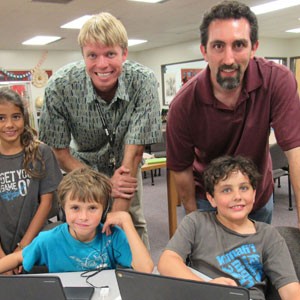
Jan 6, 2016 | Education, Innovation, Stemworks

In celebration of Computer Science Education Week in December, Hour of Code, a nationwide campaign featuring free tutorials designed to get students interested in computer science, was held at Kamaliʻi Elementary School in Kihei. Maui Economic Development Board’s Women in Technology Project (WIT) was a sponsor for the one-hour introduction. Children and adults were taught basic concepts of computer programming that offered them learning tools needed to create and communicate new ideas. “Hour of Code is an international movement to promote computer science education and call awareness to exciting 21st century career paths,” said Peter Hansen, Kamaliʻi School computer teacher. “Learning to code helps nurture problem-solving skills, logic and originality. One hour is enough to learn that computer science is fun and creative, that it is accessible for all ages, for everyone.”
The tutorials teach a computer language called JavaScript which is designed to perform a certain task. By dragging and placing blocks of code in the computer program, the code tells the computer what to display on the screen. A JavaScript function is executed when something invokes it; hence students learn that all they see and do begins with lines of computer code. “I hope that through this event Kamaliʻi School’s technology program will receive some attention and parents and community members will begin to understand the importance of having computer science education for all students, even at the elementary level,” explained Hansen. Lucy Dryhurst, Kamaliʻi 5th grader said, “I learned through Hour of Code that by following directions on a game with a lot of thinking steps, I can write code. I like doing it a lot. It is fun and creative!”
“WIT is an extraordinary program,” Hansen noted. “They offered monetary support that made it possible to provide food and drinks for Hour of Code, not to mention donating the prizes and connecting us with volunteers.” In addition to this event, WIT provides professional educational opportunities for teachers and workshops for students, developing Maui’s future workforce.
On behalf of myself and Kamali’i School thank you very much, WIT, for your continuing support for Maui County teachers and students.
Peter Hansen, Kamaliʻi School Computer Teacher
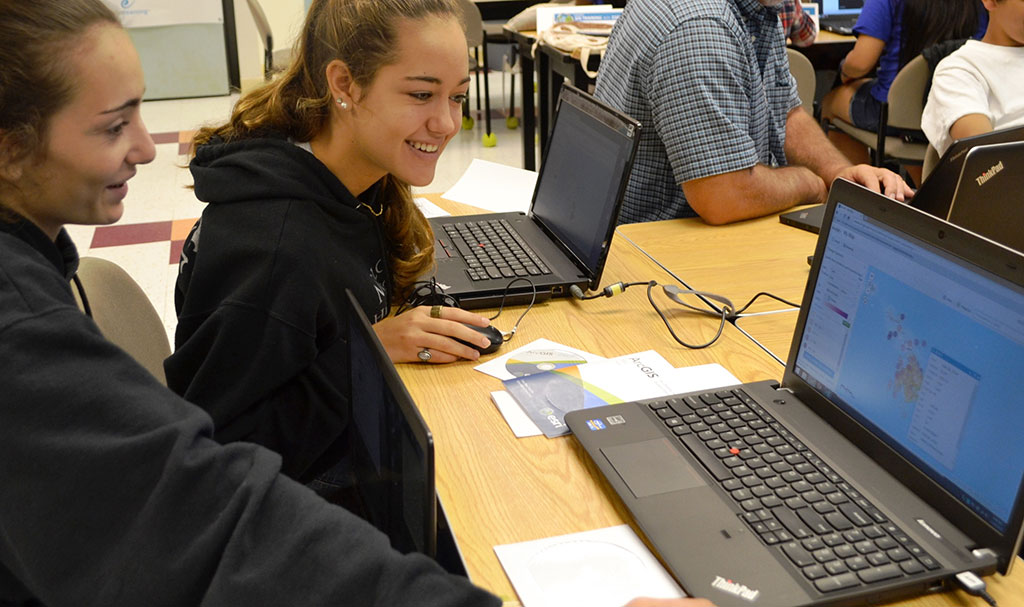
May 6, 2015 | Education, Innovation

Sarah and Lily Jenkins have more in common than being sisters, fellow students at Molokai High School and winners at the 2015 Maui Schools Science & Engineering Fair 5 for their project, “March of the Mangroves.” The sisters also share a love of science, technology, engineering and math (STEM) and a strong ambition to succeed. They’ve taken a big step toward that by winning the Maui District Science Fair, which qualified them for competition in the INTEL International Science and Engineering Fair, a contest that annually draws the nation’s best and brightest students.
The students used Geographic Information System software, known as GIS, to interpret satellite data, aerial imagery, historic maps and coastal surveys to determine the extent to which red mangroves have migrated seaward on Molokai’s south shore. The girls were also able to analyze the mangroves’ effects and predict their future impact on nearby reefs. “GIS mapping was able to prove that red mangrove will establish itself upon the fringing reef in approximately 72 years, consuming a total area of 46 square kilometers (about 18 square miles),” Lily Jenkins said. “If no management plan for red mangrove is adopted, this invasive species will overtake 35.67 percent of Molokai’s fringing reef in the next 100 years.” In the next year or two, Lily said she plans to create a nonprofit to start raising money to contribute and aid in the effort to remove and manage the invasive mangrove.
The GIS software used by the Jenkins came from the Hawaii K12 GIS Hub website, which has been made possible through a partnership of Maui Economic Development Board’s Women in Technology and ESRI, the world’s leading GIS software developer. “Without that software, we wouldn’t even have a project,” Sarah Jenkins said.
WIT recently announced the kickoff of its new Hawaii K12 GIS Community Hub: www.gishawaii.com. The new hub promises to engage educators, students and industry partners with school projects, pictures, collected data, lesson plans, news events, tips and tricks, etc. For more information, contact Isla Young at 875-2307, or e-mail: isla@medb.org

Dec 17, 2014 | Education, Innovation
 Kalama Intermediate School librarian Jody Brown said she underestimated the challenge of starting a robotics club yet still reaped rewards beyond her expectations. Thanks to a Ke Alahele Education Fund grant from the Maui Economic Development Board, Brown said she had “an amazingly positive experience. … I’m hooked. I’m ready for the next season.”
Kalama Intermediate School librarian Jody Brown said she underestimated the challenge of starting a robotics club yet still reaped rewards beyond her expectations. Thanks to a Ke Alahele Education Fund grant from the Maui Economic Development Board, Brown said she had “an amazingly positive experience. … I’m hooked. I’m ready for the next season.”
She said she found coding and building Web sites enjoyable and “naively thought this would translate well into starting a robotics club.” Brown quickly learned that there’s a lot more involved. “Luckily, my students had a variety of backgrounds and experiences and we all spent time teaching each other what we know so far.” Brown said she chose a platform based on training she received in August. “I got some free VEX IQ equipment at the training and bought a lot more with my Ke Alahele grant,” she said. She created two teams at Kalama Intermediate, one with four students and another with five. Both teams were eventually able to design and build a robot. For programming, the club used Modkit for VEX IQ, a free online program that offers a visual programming platform using color-coded and shape-coded boxes. The Kalama teams competed in the December 5-6 VEX IQ competition at Iao Intermediate School.
“The competition itself was one of the most rewarding experiences of my life,” she said. “The hosts and other teams welcomed us ‘newbies’ with open arms and helped us overcome a mountain of problems, including troubleshooting our robot brain. It turns out they were able to determine that one of the brains we bought was completely non-functioning.” The Kalama students did not take the overall award in their first competition, but they did reach the final rounds of play and were selected for the Inspire Award for innovative robot design. “Both of those accomplishments were more than I could have ever asked for or imagined,” Brown said. “It has been a delightfully rewarding activity!”
Nov 14, 2014 | Education, Innovation
Lahainaluna High School arts and communications teacher Nancy Young used her Ke Alahele Education Fund grant to create a new environment in her classroom. Now, instead of the traditional classroom setting with rows of desks for students, Young’s created more of an inspirational space for creativity and innovation. “The center of the room has a conversation area with upholstered benches, a table for art and design books and a set of drawers for cameras and iPads. I wanted my students to experience a taste of an inviting, stimulating room and to know what a career in the arts can offer. This is not just a classroom anymore. It is an environment and the kids love it and they produce really amazing work.”
Young said her second-year students are doing college-level work. They do commercial graphics projects, including banners for other schools. They’ve won awards for PBS HIKI NO television segments, and last year her students received special recognition on their diplomas plus placed second in the state in graphics. Young and her students have come a long way, with the help of Ke Alahele grants. When she began teaching full-time more than six years ago, she had only six large tables and 25 old 12-inch iBooks in a cart. But, by her third year, she had accumulated approximately 20 21.5-inch iMacs, a number of digital SLR cameras and a Canon 5100 17-inch printer that accepts roll paper or canvas. Still, there’s more to do, Young said. “What is missing is a pipeline to future education,” Young said. “I plan on visiting California design schools in the spring to see what I can do to connect us with advanced programs.” MEDB established the Ke Alahele Education Fund to power up STEM Education in Maui County.
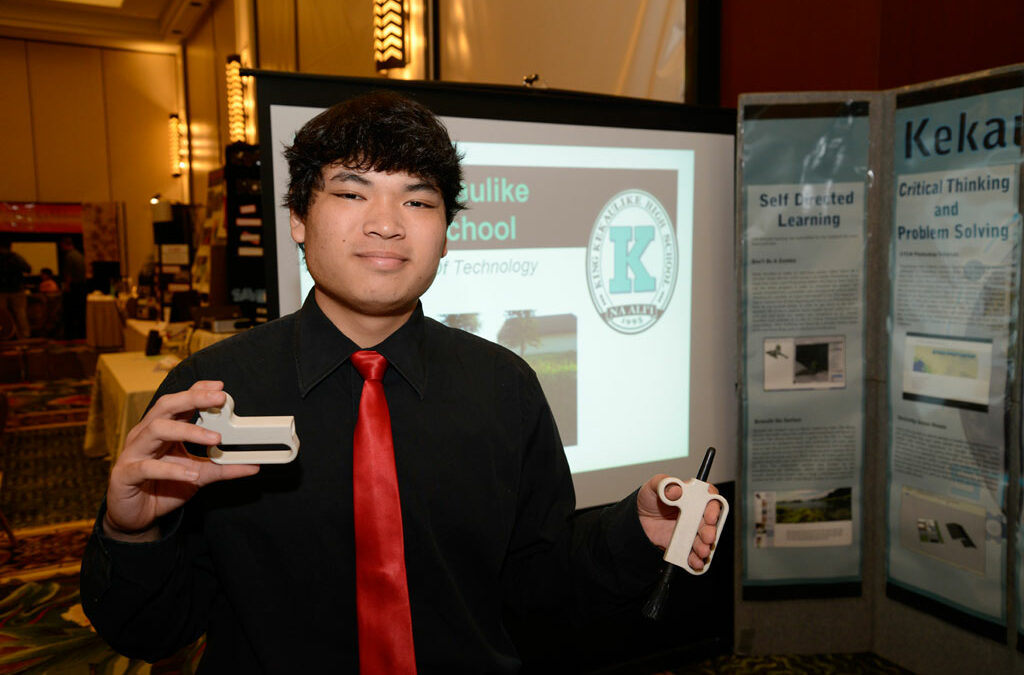
Sep 3, 2014 | Education, Innovation
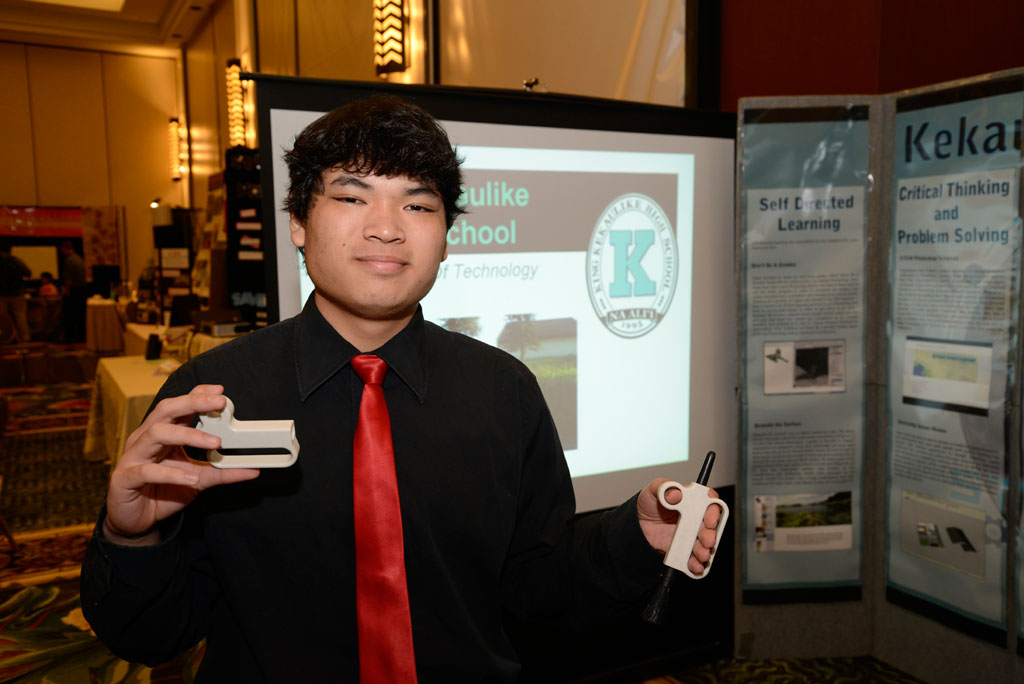 AJ Ramelb’s tenacity and technological innovation gave disabled students an independence they don’t often experience. “I really wanted my students to be able to paint their own pictures, and AJ made that possible,” said Hillary Watt, a special education teacher at King Kekaulike High School. Watt and an audience of 600-plus applauded Ramelb, a 2014 Kekaulike graduate, following his selection for this year’s Daniel K. Inouye Innovation Award from Maui Economic Development Board. Ramelb, now enrolled as a freshman at the University of Hawaii Maui College, was chosen for the award established to commemorate the late Sen. Inouye’s legacy. The honor, presented at the recent Ke Alahele Education Fund Dinner, recognizes an exceptional student-led project that applies science, technology, engineering and math solutions to community improvement.
AJ Ramelb’s tenacity and technological innovation gave disabled students an independence they don’t often experience. “I really wanted my students to be able to paint their own pictures, and AJ made that possible,” said Hillary Watt, a special education teacher at King Kekaulike High School. Watt and an audience of 600-plus applauded Ramelb, a 2014 Kekaulike graduate, following his selection for this year’s Daniel K. Inouye Innovation Award from Maui Economic Development Board. Ramelb, now enrolled as a freshman at the University of Hawaii Maui College, was chosen for the award established to commemorate the late Sen. Inouye’s legacy. The honor, presented at the recent Ke Alahele Education Fund Dinner, recognizes an exceptional student-led project that applies science, technology, engineering and math solutions to community improvement.
MEDB gave Ramelb $3,000 for college and a pledge to assist him in applying for a U.S. patent for a special paintbrush grip design. King Kekaulike will also receive $7,000 for its STEMworks™ lab. There last school year, Ramelb studied and created the paintbrush grip design for students with severe and multiple disabilities. “In a STEMworks™ lab, you have so many resources at your disposal,” Ramelb said. “I’m really grateful for my teacher, Emily Haines, and for STEM because it really opens up your mind and allows you to think about what you can do for your community.”
Ramelb created two different styles of grips, accommodating both inward and outward wrist turns of students with disabilities. They mainly use the grips for art paintbrushes, but recently used it to hold mini-maracas for music. “These kids are used to having things done for them, but these grips have given them the opportunity to do something on their own, to express themselves through movement and through art,” Watt said. She said she was impressed by Ramelb’s dedication and attention to testing the grips and adjusting the design so it could fit her students’ needs. “He really went above and beyond. I really appreciated it and couldn’t be more proud,” Watt said.











 AJ Ramelb’s tenacity and technological innovation gave disabled students an independence they don’t often experience. “I really wanted my students to be able to paint their own pictures, and AJ made that possible,” said Hillary Watt, a special education teacher at King Kekaulike High School. Watt and an audience of 600-plus applauded Ramelb, a 2014 Kekaulike graduate, following his selection for this year’s
AJ Ramelb’s tenacity and technological innovation gave disabled students an independence they don’t often experience. “I really wanted my students to be able to paint their own pictures, and AJ made that possible,” said Hillary Watt, a special education teacher at King Kekaulike High School. Watt and an audience of 600-plus applauded Ramelb, a 2014 Kekaulike graduate, following his selection for this year’s 